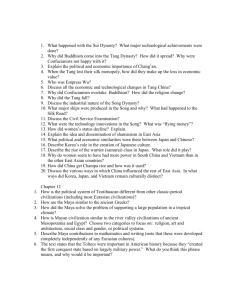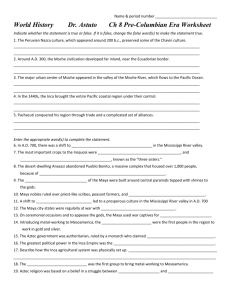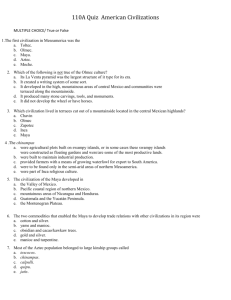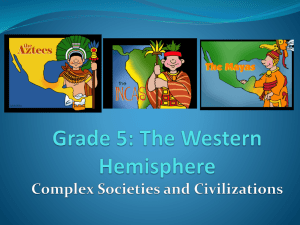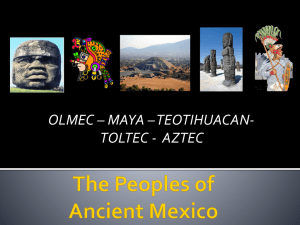Mesoamerica Lesson 1 - Mater Academy Lakes High School
advertisement
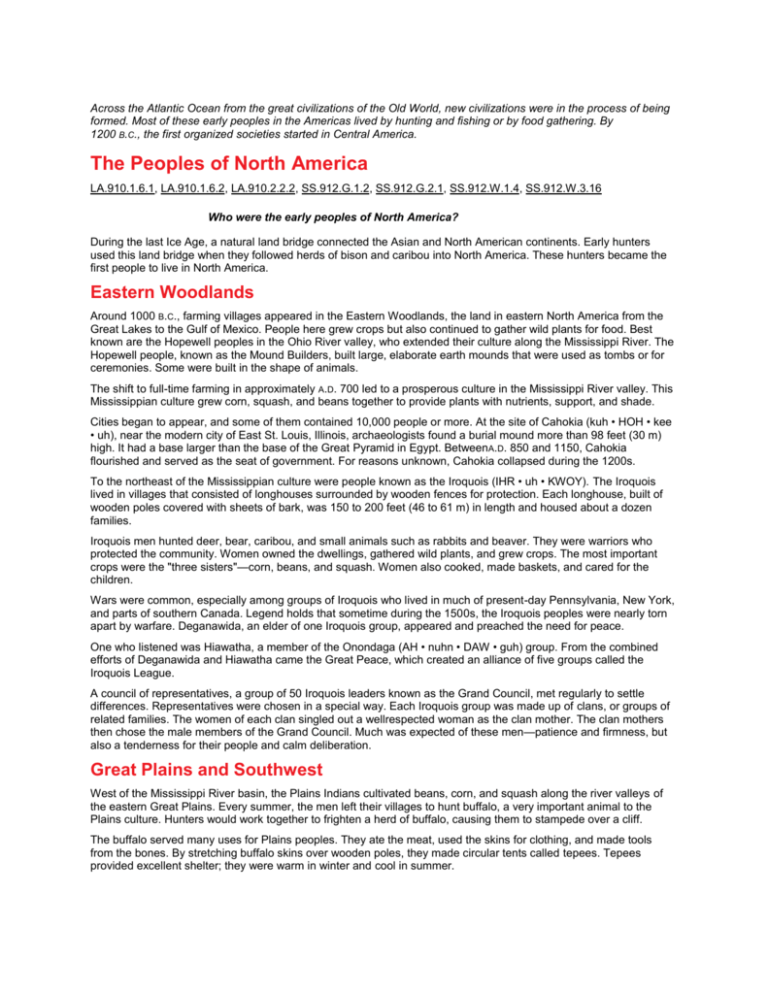
Across the Atlantic Ocean from the great civilizations of the Old World, new civilizations were in the process of being formed. Most of these early peoples in the Americas lived by hunting and fishing or by food gathering. By 1200 B.C., the first organized societies started in Central America. The Peoples of North America LA.910.1.6.1, LA.910.1.6.2, LA.910.2.2.2, SS.912.G.1.2, SS.912.G.2.1, SS.912.W.1.4, SS.912.W.3.16 Who were the early peoples of North America? During the last Ice Age, a natural land bridge connected the Asian and North American continents. Early hunters used this land bridge when they followed herds of bison and caribou into North America. These hunters became the first people to live in North America. Eastern Woodlands Around 1000 B.C., farming villages appeared in the Eastern Woodlands, the land in eastern North America from the Great Lakes to the Gulf of Mexico. People here grew crops but also continued to gather wild plants for food. Best known are the Hopewell peoples in the Ohio River valley, who extended their culture along the Mississippi River. The Hopewell people, known as the Mound Builders, built large, elaborate earth mounds that were used as tombs or for ceremonies. Some were built in the shape of animals. The shift to full-time farming in approximately A.D. 700 led to a prosperous culture in the Mississippi River valley. This Mississippian culture grew corn, squash, and beans together to provide plants with nutrients, support, and shade. Cities began to appear, and some of them contained 10,000 people or more. At the site of Cahokia (kuh • HOH • kee • uh), near the modern city of East St. Louis, Illinois, archaeologists found a burial mound more than 98 feet (30 m) high. It had a base larger than the base of the Great Pyramid in Egypt. BetweenA.D. 850 and 1150, Cahokia flourished and served as the seat of government. For reasons unknown, Cahokia collapsed during the 1200s. To the northeast of the Mississippian culture were people known as the Iroquois (IHR • uh • KWOY). The Iroquois lived in villages that consisted of longhouses surrounded by wooden fences for protection. Each longhouse, built of wooden poles covered with sheets of bark, was 150 to 200 feet (46 to 61 m) in length and housed about a dozen families. Iroquois men hunted deer, bear, caribou, and small animals such as rabbits and beaver. They were warriors who protected the community. Women owned the dwellings, gathered wild plants, and grew crops. The most important crops were the "three sisters"—corn, beans, and squash. Women also cooked, made baskets, and cared for the children. Wars were common, especially among groups of Iroquois who lived in much of present-day Pennsylvania, New York, and parts of southern Canada. Legend holds that sometime during the 1500s, the Iroquois peoples were nearly torn apart by warfare. Deganawida, an elder of one Iroquois group, appeared and preached the need for peace. One who listened was Hiawatha, a member of the Onondaga (AH • nuhn • DAW • guh) group. From the combined efforts of Deganawida and Hiawatha came the Great Peace, which created an alliance of five groups called the Iroquois League. A council of representatives, a group of 50 Iroquois leaders known as the Grand Council, met regularly to settle differences. Representatives were chosen in a special way. Each Iroquois group was made up of clans, or groups of related families. The women of each clan singled out a wellrespected woman as the clan mother. The clan mothers then chose the male members of the Grand Council. Much was expected of these men—patience and firmness, but also a tenderness for their people and calm deliberation. Great Plains and Southwest West of the Mississippi River basin, the Plains Indians cultivated beans, corn, and squash along the river valleys of the eastern Great Plains. Every summer, the men left their villages to hunt buffalo, a very important animal to the Plains culture. Hunters would work together to frighten a herd of buffalo, causing them to stampede over a cliff. The buffalo served many uses for Plains peoples. They ate the meat, used the skins for clothing, and made tools from the bones. By stretching buffalo skins over wooden poles, they made circular tents called tepees. Tepees provided excellent shelter; they were warm in winter and cool in summer. The Southwest covers the territory of present-day New Mexico, Arizona, Utah, and Colorado. Conditions are dry, but there is sufficient rain in some areas for farming. The Anasazi (AH • nuh • SAH • zee) peoples established an extensive farming society there. Between A.D. 500 and 1200, the Anasazi used canals and earthen dams to garden in the desert. They were skilled at making baskets and pottery. Using stone and adobe (sun-dried brick), they built pueblos, or multistoried structures that housed many people. At Chaco Canyon in northwestern New Mexico, they built an elaborate center for their civilization. At the heart of Chaco Canyon was Pueblo Bonito, a large complex that contained some 800 rooms housing more than 1,000 people. However, persistent droughts led the Anasazi to abandon it. The Anasazi culture did not die. In southern Colorado, a large community formed at Mesa Verde (MAY • suh VEHR • dee) (today, a national park). Groups of Anasazi built a remarkable series of buildings in the recesses of the cliff walls. However, in the late 1200s, the Anasazi abandoned the settlement due to a prolonged drought. Making Connections How did the shift to farming contribute to the development of various cultures in North America? The Maya LA.910.2.2.3, SS.912.H.1.3, SS.912.W.1.2, SS.912.W.1.3, SS.912.W.1.4, SS.912.W.1.6, SS.912.W.3.16, SS.912.W.3.17,SS.912.W.3.18, SS.912.W.3.19 What made the Maya one of the most sophisticated civilizations of the early Americas? Signs of civilization in Mesoamerica—a name we use for areas of Mexico and Central America that were civilized before the Spaniards arrived—appeared around 1200 B.C. On the Yucatán Peninsula, one of the most sophisticated civilizations in the Americas arose. This was the civilization of the Maya, which flourished between A.D. 300 and 900. The Maya built splendid temples and pyramids and developed a complicated calendar that was as accurate as any in existence in the world at that time. Maya civilization included much of Central America and southern Mexico. Sometime around 800, the Maya civilization in the central Yucatán Peninsula began to decline. Why did this happen? Explanations include invasion, internal revolt, a volcanic eruption, or overuse of the land that led to reduced crop yields. Whatever the case, Maya cities were abandoned and covered by dense jungle growth. They were not rediscovered until the nineteenth and twentieth centuries. Political and Social Structures Maya cities were built around a central pyramid topped by a shrine to the gods. Nearby were other temples, palaces, and a sacred ball court. Some scholars believe that more than 100,000 inhabitants might have lived in urban centers such as Tikal in present-day Guatemala. Maya civilization was composed of city-states, each governed by a hereditary ruling class. These Maya city-states were often at war with each other. Ordinary soldiers who were captured in battle became slaves. Captured nobles and war leaders were used for human sacrifice. In the powerful city-state of Palenque (pah • LEHNG • kay) the ruler Pacal claimed to be descended from the gods, as did other Maya rulers. These rulers were supported by nobles and a class of scribes who might also have been priests. Maya society also contained peasants and townspeople who worked as skilled artisans, officials, and merchants. Most of the Maya peasants were farmers. They lived on tiny plots or on terraced hills in the highlands. Houses were built of adobe and thatch. There was a fairly clear-cut division of labor. Men did the fighting and hunting; women provided the homemaking and raising of children. Women also made cornmeal, the basic food of much of the population. The Maya also cultivated cacao trees, the source of chocolate, which was used as a beverage by the upper classes. Religion and Culture Crucial to Maya civilization was its spiritual perspective. For the Maya, all of life was in the hands of divine powers. The name of their supreme god was Itzamna (eet • SAWM • nuh) or "Lizard House." Gods were ranked in order of importance. Some, such as the jaguar god of night, were evil rather than good. Like other ancient civilizations in Mesoamerica, the Maya practiced human sacrifice to appease the gods. Human sacrifices were also used for special ceremonial occasions. When a male heir was presented to the throne, war captives were tortured and then beheaded. The Maya created a sophisticated writing system based on hieroglyphs or pictures. Unfortunately, the Spanish conquerors of the sixteenth century had little respect for the Maya language and made no effort to decipher it. The Spaniards assumed the writings were evil or worthless and destroyed many of them. The Maya wrote on bark, folding it like an accordian, then covering the outside with thin plaster. Four of these books have survived. Maya writing was also carved into clay, jade, bone, shells, and stone monuments. Maya hieroglyphs remained a mystery for centuries. Then, scholars discovered that many passages contained symbols that recorded dates in the Maya calendar. This calendar, known as the Long Count, was based on cycles of creation and destruction. According to Maya belief, our present world was created in 3114 B.C. and is scheduled to complete its downward cycle on December 23, A.D. 2012. The Maya used two different systems for measuring time. One was based on a solar calendar of 365 days, divided into 18 months of 20 days each and an extra 5 days at the end. The other was based on a sacred calendar of 260 days, divided into 13 weeks of 20 days. Only trained priests could read and use this calendar. These priests also used mathematics for astronomical and religious purposes. Maya numerals were based on the number 20 and included a symbol for zero—a concept developed independently from European and Asian cultures. Many Maya hieroglyphics record important events in Maya history. One of the most important collections of Maya hieroglyphs is located at Palenque. There, archaeologists discovered a royal tomb covered with hieroglyphs that record the accomplishments of the great ruler Pacal. Drawing Conclusions How did the belief system of the Maya affect their daily life? The Toltec SS.912.H.3.1, SS.912.W.3.16, SS.912.W.3.18 What contributions did the Toltec make to early Mesoamerican culture? Around A.D. 1000, new peoples rose to prominence in central Mexico. Most significant were the Toltec. The Toltec empire reached its high point between A.D. 950 and 1150. The center of the empire was Tula, which was built on a high ridge about 43.5 miles (70 km) northwest of present-day Mexico City. The Toltec irrigated their fields with water from the Tula River and grew a number of crops, including beans, maize, and peppers. This agriculture enabled Tula to support a population of 40,000 to 60,000 people. The Toltec were a warlike people. Their empire included much of northern and central Mexico. They also extended their conquests into the Maya lands of Guatemala and the northern Yucatán. The Toltec controlled the upper Yucatán Peninsula from Chichén Itzá for centuries. The Toltec were also builders who constructed pyramids and palaces. They brought metal-working to Mesoamerica and were the first people in the region to work in gold, silver, and copper. The Toltec empire began to decline around 1125 as a result of fighting among different groups in Tula. Around 1170, the city was sacked and much of it burned. There was no single ruling group for nearly 200 years until the Aztec Empire emerged, carrying on many Toltec traditions. Identifying What caused the decline of the Toltec empire? The Aztec SS.912.H.1.3, SS.912.W.1.2, SS.912.W.1.3, SS.912.W.1.6, SS.912.W.3.16, SS.912.W.3.17, SS.912.W.3.18, SS.912.W.3.19 How did the Aztec continue the tradition of building successful civilizations in Mesoamerica? The origins of the Aztec are uncertain. Sometime during the twelfth century, they began a long migration that brought them to the Valley of Mexico. They eventually established a capital at Tenochtitlán (tay • NAWCH • teet • LAHN), now Mexico City. According to their legends, when the Aztec arrived in the Valley of Mexico, other peoples drove them into a snakeinfested region. However, the Aztec survived, strengthened by their belief in a sign. Huitzilopochtli (wee • tsee • loh • POHKT • lee), their god of war and of the sun, had told them that when they saw an eagle perched on a cactus growing out of a rock, their journey would end. In 1325 under attack by another people, they were driven into the swamps and islands of Lake Texcoco (tehs • KOH • koh). On one island, they saw an eagle standing on a prickly pear cactus on a rock. There they built Tenochtitlán (or "place of the prickly pear cactus"): Now we have found the land promised to us. We have found . . . peace for the weary Mexican people. Now we want for nothing. —quoted in 500 Nations For the next 100 years, the Aztec constructed temples, other public buildings, and houses. They built roadways of stone across Lake Texcoco to the north, south, and west, linking the islands to the mainland. The Aztec at Tenochtitlán formed a Triple Alliance with two other city states, Tetzcoco and Tlacopan. This alliance enabled the Aztec to dominate an empire that included much of today’s Mexico, from the Atlantic to the Pacific Ocean and as far south as the Guatemalan border. This alliance lasted until the reign of Montezuma and the arrival of Spanish in the 1500s. The new Aztec kingdom was not a centralized state but a collection of semi-independent territories that local lords governed. The Aztec ruler supported these rulers in return for tribute, goods or money paid by conquered peoples to their conquerors. Political and Social Structures By 1500, as many as four million Aztec lived in the Valley of Mexico and the surrounding valleys of central Mexico. Like all great empires in ancient times, the Aztec state was authoritarian. The monarch, who claimed lineage with the gods, held all power. A council of lords and government officials assisted the Aztec ruler. The nobility, the elite of society, held positions in the government. Noble male children were sent to temple schools, which stressed military training. When they became adults, males would select a career in the military service, the government bureaucracy, or the priesthood. As a reward for their services, nobles received large estates from the government. The rest of the population consisted of indentured workers, slaves, and commoners. Indentured workers were landless laborers who contracted to work on the nobles’ estates. Sold in the markets, male and female slaves worked in wealthy households. Most people were commoners, many of whom were farmers. Farmers built chinampas, swampy islands crisscrossed by canals that provided water for their crops. The canals also provided easy travel to local markets. Aztec merchants were active traders. Especially in Tenochtitlán and other large cities, merchants exported and traded goods made by Aztec craftspeople from imported raw materials. In exchange for their goods, the traders obtained tropical feathers, cacao beans, animal skins, and gold. When the Spanish arrived, they were astonished to find city markets that were considerably larger and better stocked than any markets in Spain. From infancy, boys and girls in Aztec society had very different roles. The midwife who attended the birth of a male infant said, "You must understand that your home is not here where you have been born, for you are a warrior." To a female infant, the midwife said, "As the heart stays in the body, so you must stay in the house." Though not equal to men, Aztec women could own and inherit property and enter into contracts, something not often allowed in other world cultures at the time. Most women worked in the home, weaving textiles and raising children. However, some were trained as priestesses. Religion and Culture Like other peoples in Central America and around the world, the Aztec had a polytheistic religion, believing in many gods. There was a supreme god, called Ometeotl, who represented the all-powerful forces of the heavens. Huitzilopochtli, the god of the sun and war, was particularly important to Aztec warriors as they expanded control over neighboring peoples. Another important god was Quetzalcoatl, who had a more direct impact on the lives of the people. According to Aztec tradition, Quetzalcoatl had left his homeland in the Valley of Mexico in the tenth century, promising to return in triumph. When the Aztec first saw Spanish explorers in the 1500s, they believed that representatives of Quetzalcoatl had returned. Aztec religion was based on a belief in an unending struggle between the forces of good and evil throughout the universe. This struggle created and destroyed four worlds, or suns. People believed they were now living in the time of the fifth sun. This world, too, was destined to end with the destruction of Earth by earthquakes. To postpone the day of reckoning, the Aztec practiced human sacrifice, which they believed would appease the sun god Huitzilopochtli. Religion had a significant influence on Aztec art and architecture. At the center of Tenochtitlán was the sacred district, dominated by a massive pyramid dedicated to Huitzilopochtli. At the top was a platform containing shrines to the gods and an altar for performing human sacrifices. The Aztec also made advances in astronomy, which is evident in their sun calendar. It contained pictographs that showed days, months, and larger cosmic cycles. Like those of the Maya, Aztec priests not only computed the calendar, but also observed the movements of the stars and planets to gain knowledge of the future. Like the Maya, the Aztec also had a number system based on units of 20. Understanding Relationships What factors indicate that the Aztec had an advanced civilization? Reviewing Vocabulary 1. Describing Where was Cahokia located, and how was it important to the Hopewell peoples? What did archaeologists find at the site? Be specific. LA.910.1.6.1, LA.910.1.6.2, SS.912.W.1.6 Using Your Notes 2. Comparing and Contrasting Use your notes to compare and contrast the three great Mesoamerican civilizations. LA.910.2.2.2, LA.910.2.2.3, SS.912.W.1.6, SS.912.W.3.17, SS.912.W.3.18 Answering the Guiding Questions 3. Listing Who were the early peoples of North America? LA.910.2.2.2 4. Identifying What made the Maya one of the most sophisticated civilizations of the early Americas? LA.910.2.2.2, SS.912.W.3.18 5. Summarizing What contributions did the Toltec make to early Mesoamerican culture? LA.910.2.2.2, SS.912.W.3.18 6. Analyzing How did the Aztec continue the tradition of building successful civilizations in Mesoamerica? LA.910.2.2.2, SS.912.W.3.18 Writing Activity 7. EXPOSITORY How were the Maya, Toltec, and Aztec civilizations influenced by geography? Be specific. LA.910.2.2.2, SS.912.G.1.2, SS.912.W.3.16
